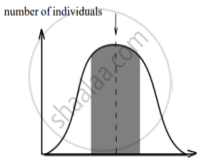Advertisements
Advertisements
प्रश्न
In a certain population, the frequency of three genotypes is as follows:
| Genotypes: | BB | Bb | bb |
| frequency: | 22% | 62% | 16% |
What is the likely frequency of B and b alleles?
उत्तर
Frequency of B allele = all of BB + ½ of Bb = 22 + 31 = 53%
frequency of b allele = all of bb + ½ of Bb = 16 + 31 = 47%
APPEARS IN
संबंधित प्रश्न
With the help of an algebraic equation, how did Hardy-Weinberg explain that in a given population the frequency of occurrence of alleles of a gene is supposed to remain the same through generations?
According to the Hardy-Weinberg principle, the allele frequency of a population remains constant. How do you interpret the change of frequency of alleles in a population?
How does the Hardy-Wienberg equation explain genetic equilibrium?
Multiple choice question.
In Hardy - Weinberg equation, the frequency of homozygous recessive individual is represented by:
Very short answer question.
State the Hardy – Weinberg equilibrium.
List any two factors that can disturb the genetic equilibrium.
At a particular locus, the frequency of allele A is 0.8, and that of allele a is 0.2. What would be the frequency of heterozygotes in a random mating population at equilibrium?
The graphs below show three types of natural selection. The shaded areas marked with arrows show the individuals in the population who are not selected. The dotted vertical lines show the statistical means.
 |
 |
 |
| character Graph A |
character Graph B |
character Graph C |
- What names are given to the types of selection shown in graphs A, B and C?
- After the selection has operated for several generations in the above populations indicated as, Graph A, B and C, graphically illustrate the probable results.
Explain Hardy-Weinberg's principle
Give a mathematical expression for Hardy Weinberg's principle.
